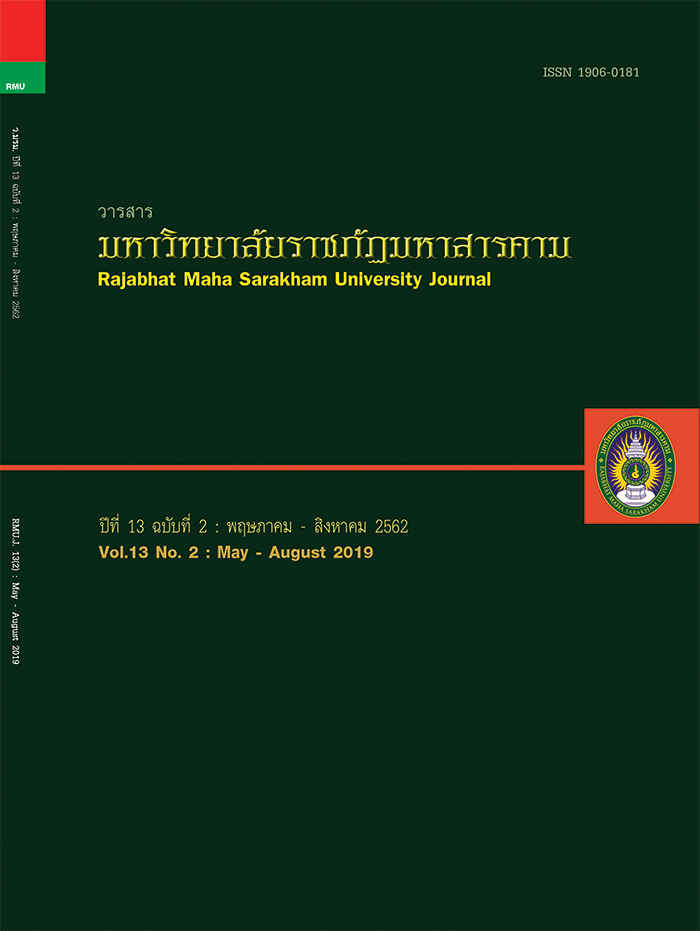พฤติกรรมการบริโภคของชาวลาวที่มีต่อสินค้าไทยตามด่านชายแดนจังหวัดเลย
Main Article Content
บทคัดย่อ
การวิจัยนี้มีวัตถุประสงค์หลักเพื่อศึกษาปัจจัยพฤติกรรมการบริโภคของชาวลาวที่มีต่อสินค้าไทยด้านส่วนประสมทางการตลาด ด้านระยะห่างทางวัฒนธรรม และด้านความพึงพอใจของผู้บริโภค ตามด่านชายแดนจังหวัดเลย ที่มีผลทำให้เกิดการตัดสินใจซื้อสินค้า กลุ่มตัวอย่าง คือ ผู้บริโภคชาวลาวที่ข้ามมาซื้อสินค้าตามด่านชายแดนจังหวัดเลย ทั้งหมด 6 ด่านจำนวน 323 รายใช้การสุ่มตัวอย่างแบบอย่างง่าย เครื่องมือที่ใช้ในการวิจัย คือ แบบสอบถามพฤติกรรมการบริโภคของชาวลาวที่มีต่อสินค้าไทยตามด่านชายแดนจังหวัดเลยแบ่งออกเป็น 5 ส่วน ได้แก่ 1) ข้อมูลพื้นฐานเกี่ยวกับผู้บริโภคชาวลาวได้แก่ เพศ อายุ สถานภาพ ระดับการศึกษา อาชีพ รายได้ครัวเรือนและค่าใช้จ่ายเพื่อการบริโภคของครอบครัว ลักษณะเป็นปลายปิดแบบตรวจสอบรายการ (Check List) จำนวน 7ข้อ 2) ข้อมูลความคิดเห็นเกี่ยวกับส่วนประสมทางการตลาด 4 ด้าน ได้แก่ ด้านผลิตภัณฑ์ ด้านราคา ด้านช่องทางการจัดจำหน่าย และด้านการส่งเสริมการตลาด ลักษณะเป็นปลายปิดแบบตรวจสอบรายการ (Check List) จำนวน 33 ข้อ 3)ข้อมูลความคิดเห็นเกี่ยวกับระยะห่างทางวัฒนธรรม ลักษณะเป็นปลายปิดแบบตรวจสอบรายการ (Check List) จำนวน 4 ข้อ4) ข้อมูลความคิดเห็นเกี่ยวกับความพึงพอใจของผู้บริโภค ลักษณะเป็นปลายปิดแบบตรวจสอบรายการ (Check List) จำนวน 8 ข้อและ 5) ข้อมูลความคิดเห็นเกี่ยวกับการตัดสินใจซื้อลักษณะเป็นปลายปิดแบบตรวจสอบรายการ (Check List) จำนวน 6 ข้อ ค่าความเที่ยงตรงด้านเนื้อหา มีค่าดัชนีความสอดคล้อง ระหว่าง 0.67-1.00ค่าอำนาจจำแนกรายข้อระหว่าง 0.34-0.88ค่าความเชื่อมั่นทั้งฉบับเท่ากับ 0.94สถิติที่ใช้คือ การวิเคราะห์องค์ประกอบเชิงสำรวจ (Exploratory Factor Analysis) และวิเคราะห์ความสัมพันธ์ของเพียร์สันผลการวิจัย พบว่าพฤติกรรมการบริโภคของชาวลาวที่มีต่อสินค้าไทยสกัดและจัดกลุ่มปัจจัยได้ 4 ปัจจัย ได้แก่ 1) ส่วนประสมทางการตลาด ประกอบด้วย 33ตัวชี้วัด2)ระยะห่างทางวัฒนธรรมประกอบด้วย 4 ตัวชี้วัด3)ความพึงพอใจของผู้บริโภคประกอบด้วย 8 ตัวชี้วัดและ4) ด้านการตัดสินใจซื้อ ประกอบด้วย 6 ตัวชี้วัด ส่วนการวิเคราะห์ความสัมพันธ์ระหว่างส่วนประสมทางการตลาดกับความพึงพอใจของผู้บริโภคชาวลาวมีค่าเท่ากับ 0.522 ความสัมพันธ์ในระดับปานกลาง และมีความสัมพันธ์ในทิศทางเดียวกัน ความสัมพันธ์ระหว่างระยะห่างทางวัฒนธรรมกับความพึงพอใจของผู้บริโภคชาวลาวมีค่าเท่ากับ 0.547 ความสัมพันธ์ในระดับปานกลาง และมีความสัมพันธ์ในทิศทางเดียวกัน และความสัมพันธ์ระหว่างความพึงพอใจของผู้บริโภคชาวลาวกับการตัดสินใจซื้อสินค้าไทย มีค่าเท่ากับ 0.540 ความสัมพันธ์ในระดับปานกลาง และมีความสัมพันธ์ในทิศทางเดียวกันข้อเสนอแนะในการเพิ่มศักยภาพทางการแข่งขันอย่างมีประสิทธิภาพเพื่อการตอบสนองความต้องการของผู้บริโภคชาวลาวได้อย่างเหมาะสม และขยายตลาดผู้บริโภคชาวลาวออกไปได้ ผู้ประกอบการไทยต้องเพิ่มช่องทางการจัดจำหน่ายสินค้าออนไลน์รักษาคุณภาพของสินค้า มีการพัฒนาสินค้าให้หลากหลายมากยิ่งขึ้น และควรเพิ่มการโฆษณาให้หลากหลายในพื้นที่ของ สปป.ลาว
Article Details
1. บทความที่ลงตีพิมพ์ทุกเรื่องได้รับการตรวจทางวิชาการโดยผู้ประเมินอิสระ ผู้ทรงคุณวุฒิ (Peer Review) สาขาที่เกี่ยวข้อง อย่างน้อย 3 ท่าน ในรูปแบบ Double blind review
2. ข้อคิดเห็นใด ๆ ของบทความที่ลงตีพิมพ์ในวารสารมหาวิทยาลัยราชภัฏมหาสารคาม นี้เป็นของผู้เขียน คณะผู้จัดทำวารสารไม่จำเป็นต้องเห็นด้วย
3. กองบรรณาธิการวารสารมหาวิทยาลัยราชภัฏมหาสารคาม ไม่สงวนสิทธิ์การคัดลอกแต่ให้อ้างอิงแสดงที่มา
เอกสารอ้างอิง
Nongkhai Business Support Center Office of Commercial Affairs Nongkai. (2012).Border trade with neighboring countries between Thailand - Lao PDR,2012.NongKhai: Office of Commercial Affairs Nongkai.
Prachachat. (2018). Economy : Regional Economy. Retrieved June 24, 2018fromhttps://www.prachachat.net/local-economy/news-146911
Department of Foreign Trade. (2018). Border Trade and Border Trade Statistics of Thailand. Retrieved March 2, 2018fromhttp://www.dft.go.th/bts/trade-report
Sincharu, T. (2014).Statistical Research and Analysis with SPSS and AMOS.Bangkok: S.R.Printing Mass Products Co., Ltd.
Vanichbuncha, K. (2011). Advanced Statistics Analysis with SPSS. Bangkok: Thammasan Co., Ltd.
Keohane, R.O. & Nye, J.S. (2001). Power and Interdependence. 3thed. New York: Longman.
Ahmed, S. A. &d’Astous, A. (2007).Moderating effect of nationality on country-of-origin perception: English-speaking Thailand versus French-speaking Canada. Journal of Business Research, 60, 240-248.
Fandos, C. & Flavian, C. (2006). Intrinsic and extrinsic quality attributes, loyalty and buy intention: an analysis for a PDO product. British Food Journal, 108(8), 646-662.
Ha, J., & Jang, S. (2010). Perceived values, satisfaction, and behavioral intentions: The role of familiarity in Korean restaurants. International Journal of Hospitality Management, 29, 2-13.
Lord, K.R., Putrevu, S. &Parsa, H.G. (2004). The cross-border consumer: Investigation of motivators and inhibitors in dinning experiences. Journal of Hospitality & Tourism Research, 28(2), 209-229.
Bygvra, S. (1998). The road to the single European market as seen through the Danish retail trade: cross-border shopping between Denmark and Germany, The International Review of Retail, Distribution and Consumer Research, 8, 147-164.
Van Riel, A.C., Pahud, M.C. &Streukens, S. (2005). Marketing antecedents of industrial brand equity: An empirical investigation in specialty chemicals. Industrial Marketing Management, 34(8), 841-847.
Schuiling, I. & Moss, G. (2004). How different are branding strategies in the pharmaceutical industry and the fast-moving consumer goods sector. Journal of Brand Management, 11(5), 366-380.
Yoo, B., Donthu, N. & Lee, S. (2000). An examination of selected marketing mix elements and brand equity. Journal of the Academy of Marketing Science, 28(2), 195-212.
Azzadina, I., Huda, A. N. &Sianipar, C.P. (2012). Understanding relationship between personality types, marketing – mix factors and purchasing decisions. Procedia-Social and Behavioral Sciences, 65, 352-357.
Espejel, J., Fandos, C, & Flavian, C. (2008). The influence of consumer degree of knowledge on consumer behavior: the case of Spanish olive oil. Journal of Food Products Marketing, 15(1), 15-37.
Ajzen, I. (2011). The Theory of planned behavior: Reactions and reflections. Psychology and Health, 26(9), 1113-1127.
Balabanis, G., Mueller, R. & Melewar, T. C. (2002). The cultural lenses of country of origin image. International Marketing Review, 19(6), 582-610.
Kuhn, K.L., Alpert, F., & Pope, N.K. (2008). An application of Keller’s brand equity model in a B2B context. Qualitative Marketing Research: An International Journal, 11(1), 40-58.
Kim, J.H. & Hyun, Y.J. (2011). A model to investigate the influence of marketing-mix efforts and corporate image on brand equity in the IT solfware sector. Industrial Marketing Management, 40, 424-438.
Lindridge, A. &Dibb, S. (2003). Is culture a justifiable variable for market segmentation? A cross-cultural example. Journal of Consumer Behavior, 2(3), 269-286.
Kwak, H.D. & Kang, H.J. (2009). Symbolic purchase in sport: The role of self-image congruence and perceived quality. Management Decision, 47(1), 887-896.


